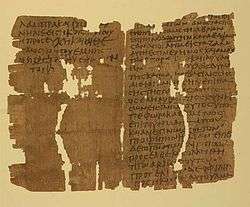Acts 10
| Acts 10 | |
|---|---|
|
Acts 10:26-31 in Papyrus 50, written in 3rd century. | |
| Book | Acts of the Apostles |
| Bible part | New Testament |
| Order in the Bible part | 5 |
| Category | Church history |
Acts 10 is the tenth chapter of the Acts of the Apostles in the New Testament of the Christian Bible. It records the vision of Saint Peter and his meeting with Cornelius in Caesarea.[1] The book containing this chapter is anonymous but early Christian tradition uniformly affirmed that Luke composed this book as well as the Gospel of Luke.[2]
Text
The original text is written in Koine Greek and is divided into 48 verses. Some most ancient manuscripts containing this chapter are:
- Papyrus 50 (3rd century; extant: verses 26-31)
- Papyrus 53 (3rd century; extant: verse 1)
- Codex Vaticanus (AD 325-350)
- Codex Sinaiticus (AD 330-360)
- Codex Bezae (ca. AD 400)
- Codex Alexandrinus (ca. AD 400-440)
- Codex Ephraemi Rescriptus (ca. AD 450; extant: verses 1-42)
- Papyrus 127 (5th century; extant: verses 32-35, 40-45)
- Codex Laudianus (ca. AD 550)
Location
This chapter mentions the following places:

Structure
This chapter can be grouped:
- Acts 10:1-8 = Cornelius Sends a Delegation
- Acts 10:9-16 = Peter's Vision
- Acts 10:17-23 = Summoned to Caesarea
- Acts 10:24-33 = Peter Meets Cornelius
- Acts 10:34-43 = Preaching to Cornelius’ Household
- Acts 10:44-48 = The Holy Spirit Falls on the Gentiles
Verse 15
- And a voice spoke to him again the second time, “What God has cleansed you must not call common.”[3]
Verse 32
- [The man in Cornelius's vision said:] ‘Send therefore to Joppa and call Simon here, whose surname is Peter. He is lodging in the house of Simon, a tanner, by the sea. When he comes, he will speak to you.’ [4]
Peter's vision

In the story recorded in this chapter, Saint Peter had a vision of a sheet full of animals being lowered from heaven. A voice from heaven told Peter to kill and eat, but since the sheet contained unclean animals, Peter declined. The command was repeated two more times, along with the voice saying, "What God hath cleansed, that call not thou common" (verse 15) and then the sheet was taken back to heaven (Acts 10:16). The triple refusal here echoes the denial of Peter described in the Synoptic Gospels.[5][6] At this point in the narrative, messengers sent from Cornelius the Centurion arrive and urge Peter to go with them. He does so, and mentions the vision as he speaks to Cornelius, saying "God hath shewed me that I should not call any man common or unclean" (Acts 10:28, KJV). Peter related the vision again in Acts 11:4-9.
Simon J. Kistemaker suggests that the lesson God taught Peter in this vision is that "God has removed the barriers he once erected to separate his people from the surrounding nations."[7] Kistemaker argues that it means Peter has to accept Gentile believers as full members of the Christian Church, but also that God has made all animals clean, so that "Peter with his fellow Jewish Christians can disregard the food laws that have been observed since the days of Moses."[8] Luke Timothy Johnson and Daniel J. Harrington write that this episode heralds a radical change in Peter's "identity as a member of God's people,"[9] but also that "the implication is that all things God created are declared clean by him, and are not affected by human discriminations."[10]
See also
- Caesarea
- Cornelius the Centurion
- Joppa
- Peter's vision of a sheet with animals
- Simon Peter
- Other related Bible parts: Acts 9, Acts 11, Acts 15
References
- ↑ Halley, Henry H. Halley's Bible Handbook: an abbreviated Bible commentary. 23rd edition. Zondervan Publishing House. 1962.
- ↑ Holman Illustrated Bible Handbook. Holman Bible Publishers, Nashville, Tennessee. 2012.
- ↑ Acts 10:15
- ↑ Acts 10:32
- ↑ Ben Witherington, The Acts of the Apostles: A Socio-Rhetorical Commentary (Grand Rapids: Eerdmans, 2008), 350.
- ↑ Josep Rius-Camps and Jenny Read-Heimerdinger, The Message of Acts in Codex Bezae: A comparison with the Alexandrian tradition, Volume 2 (Continuum, 2006), 253.
- ↑ Simon J. Kistemaker, Exposition of the Acts of the Apostles (Grand Rapids: Baker, 1990), 378.
- ↑ Kistemaker, Acts, 380.
- ↑ Luke Timothy Johnson and Daniel J. Harrington, The Acts of the Apostles (Collegeville, MN: Liturgical Press, 1992), 187.
- ↑ Johnson and Harrington, 184.
